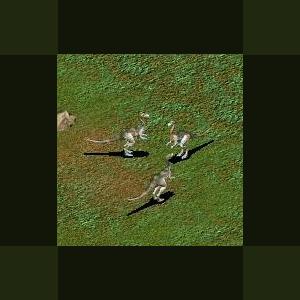About This File
Parksosaurus
Parksosaurus ("William Parks's lizard") was a genus of hypsilophodont ornithopod dinosaur from the early Maastrichtian-age Upper Cretaceous Horseshoe Canyon Formation of Alberta, Canada. It is based on most of a partially articulated skeleton and partial skull, showing it to have been a small, bipedal, herbivorous dinosaur. It is one of the few described non-hadrosaurid ornithopods from the end of the Cretaceous in North America, existing around 70 million years ago.
Explicit estimates of the entire size of the animal have not been done, but William Parks found the hindlimb of his T. warreni to be about the same length overall as that of Thescelosaurus neglectus (93.0 centimeters (3.05 ft) for T. warreni versus 95.5 centimeters (3.13 ft) for T. neglectus), even though the shin was shorter than the thigh in T. neglectus, the opposite of T. warreni. Thus, the animal would have been comparable to the better-known Thescelosaurus in linear dimensions, despite proportional differences (around 1 meter (3.3 ft) tall at the hips, 2-2.5 meters (6.56-8.2 ft) long). The proportional differences probably would have made it lighter, though, as less weight was concentrated near the thigh. Like Thescelosaurus, it had thin cartilaginous plates along the ribs.
Parksosaurus has been considered to be a hypsilophodont since its description. Recent reviews have dealt with it with little comment, although David B. Norman and colleagues (2004), in the framework of a paraphyletic Hypsilophodontidae, found it to be the sister taxon to Thescelosaurus, and Richard Butler and colleagues (2008) found that it may be close to the South American genus Gasparinisaura. However, basal ornithopod phylogeny is poorly known at this point, albeit under study. Like Thescelosaurus, Parksosaurus had a relatively robust hindlimb, and an elongate skull without as much of an arched shape to the forehead compared to other hypsilophodonts.
Paleontologist William Parks described skeleton ROM 804 in 1926 as Thescelosaurus warreni, which had been discovered in what was then called the Edmonton Formation near Rumsey Ferry on the Red Deer River. When found, it consisted of a partial skull missing the beak region, most of the left pectoral girdle (including a suprascapula, a bone more commonly found in lizards, but which is believed to have been present in cartilaginous form in some ornithopods due to the roughened ends of their scapulae), the left arm except the hand, ribs and sternal elements, a damaged left pelvis, right ischium, the left leg except for some toe bones, articulated vertebrae from the back, hip, and tail, and a number of ossified tendons that sheathed the end of the tail. The body of the animal had fallen on its left side, and most of the right side had been destroyed before burial; in addition, the head had been separated from the body, and the neck lost. Parks differentiated the new species from T. neglectus by leg proportions; T. warreni had a longer tibia than femur, and longer toes.
Charles M. Sternberg, upon the discovery of the specimen he named Thescelosaurus edmontonensis, revisited T. warreni and found that it warranted its own genus (it was named in an abstract, which is not typical, but the specimen had already been thoroughly described). In 1940, he presented a more thorough comparison and found a number of differences between the two genera throughout the body. He assigned Parksosaurus to the Hypsilophodontinae with Hypsilophodon and Dysalotosaurus, and Thescelosaurus to the Thescelosaurinae. The genus attracted little attention until Peter Galton began his revision of hypsilophodonts in the 1970s. Parksosaurus received a redescription in 1973, wherein it was considered to be related to a Hypsilophodon\Laosaurus\L. minimus lineage. After this, it once again returned to obscurity.
George Olshevsky emended the species name to P. warrenae in 1992, because the species name honors a woman (Mrs. H. D. Warren), but outside of Internet sites, the original spelling has been preferred.
Parksosaurus shared the Horseshoe Canyon Formation with flat-headed hadrosaurid Edmontosaurus, spike-crested Saurolophus, and hollow-crested Hypacrosaurus, ankylosaurid Euoplocephalus, nodosaurid Edmontonia, horned dinosaurs Montanoceratops, Anchiceratops, Arrhinoceratops, and Pachyrhinosaurus, pachycephalosaurid Stegoceras, ostrich-mimics Ornithomimus and Struthiomimus, a variety of poorly-known small theropods including troodontids and dromaeosaurids, and the tyrannosaurids Albertosaurus and Daspletosaurus. The dinosaurs from this formation are sometimes known as Edmontonian, after a land mammal age, and are distinct from those in the formations above and below. The Horseshoe Canyon Formation is interpreted as having a significant marine influence, due to an encroaching Western Interior Seaway, the shallow sea that covered the midsection of North America through much of the Cretaceous.
In life, Parksosaurus, as a hypsilophodont, would have been a small, swift bipedal herbivore. It would have had a moderately long neck and small head with a horny beak, short but strong forelimbs, and long powerful hindlimbs.



Recommended Comments
There are no comments to display.
Create an account or sign in to comment
You need to be a member in order to leave a comment
Create an account
Sign up for a new account in our community. It's easy!
Register a new accountSign in
Already have an account? Sign in here.
Sign In Now